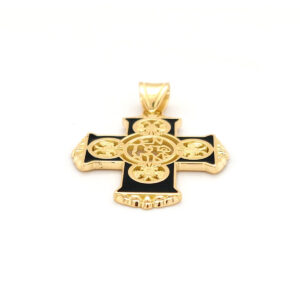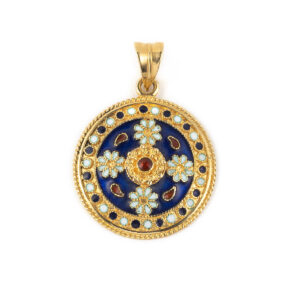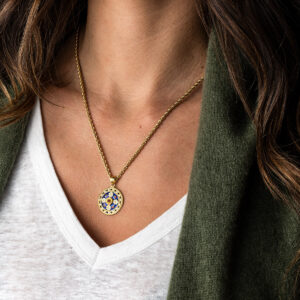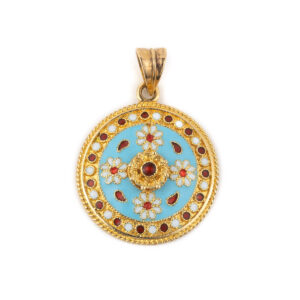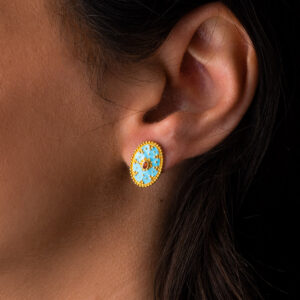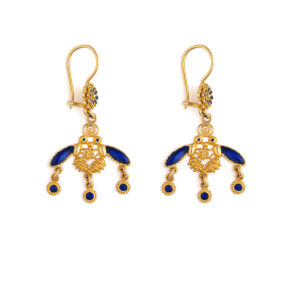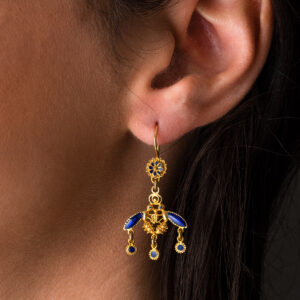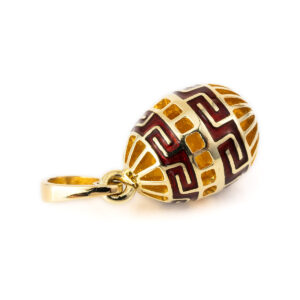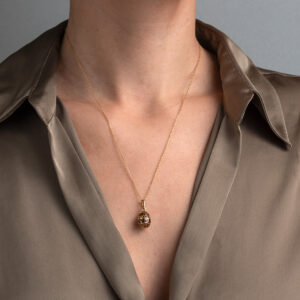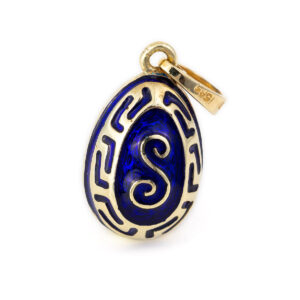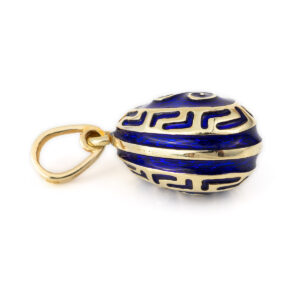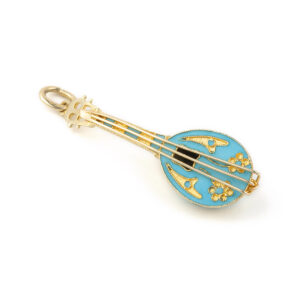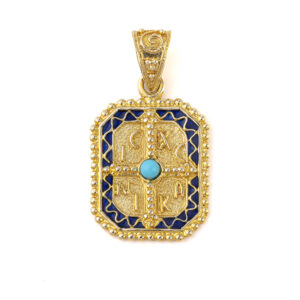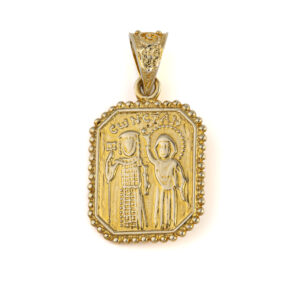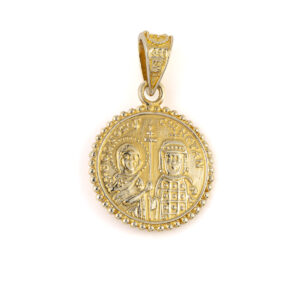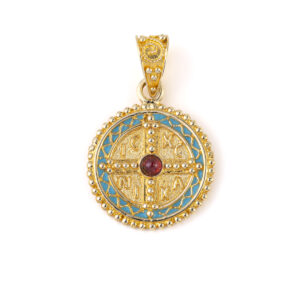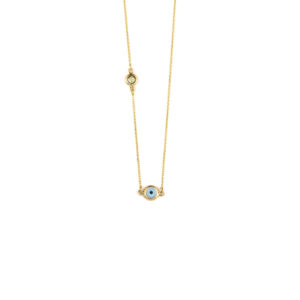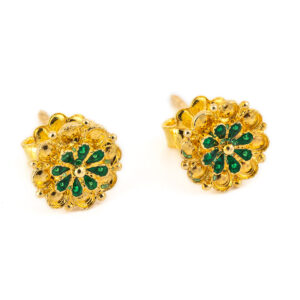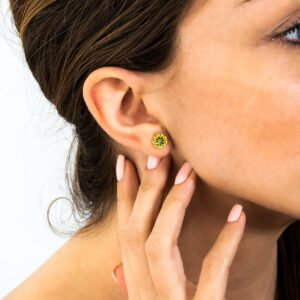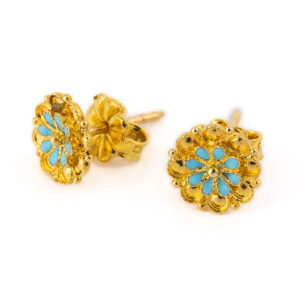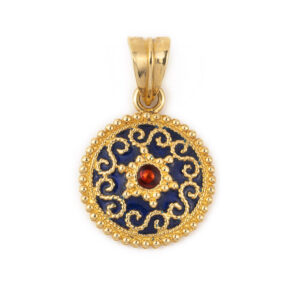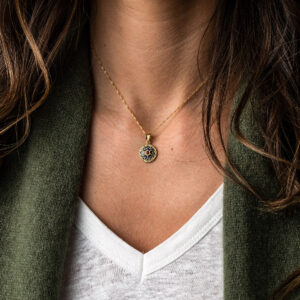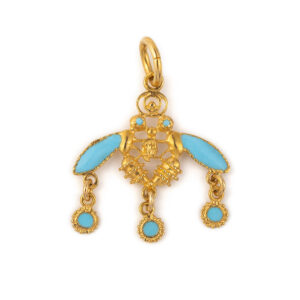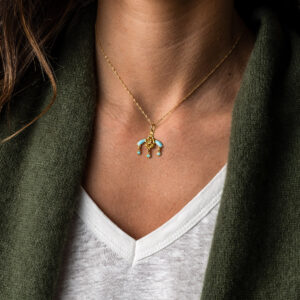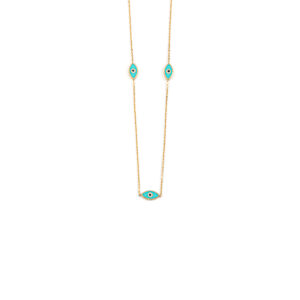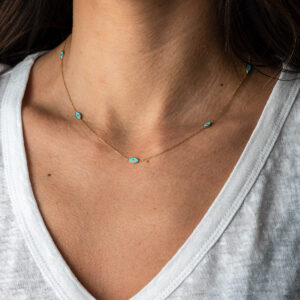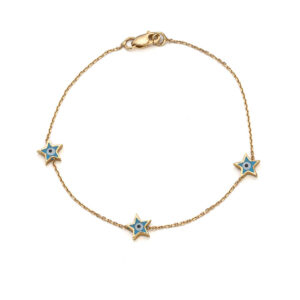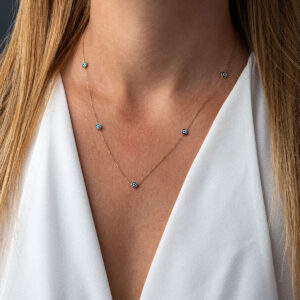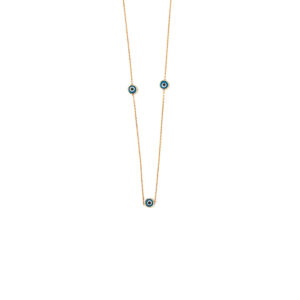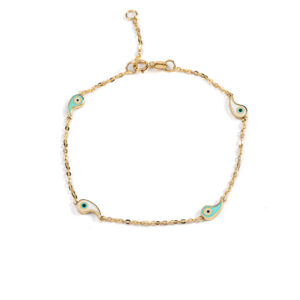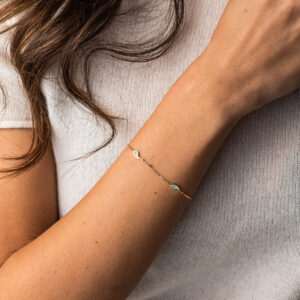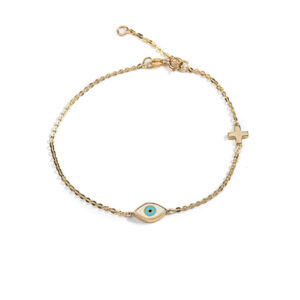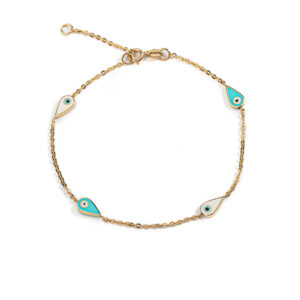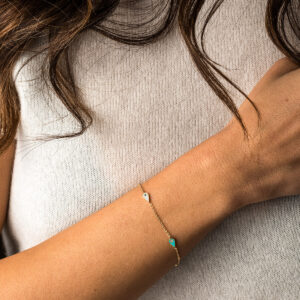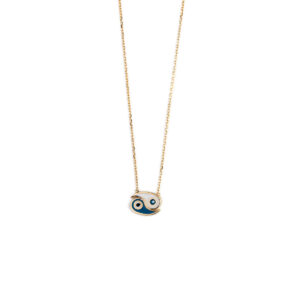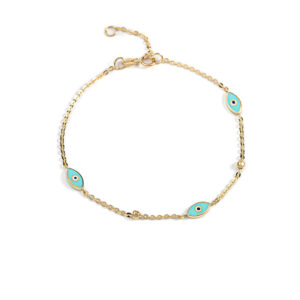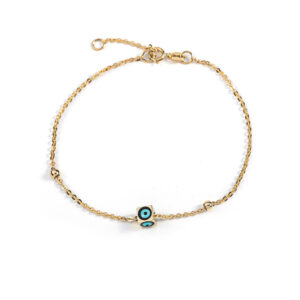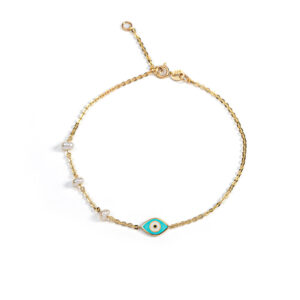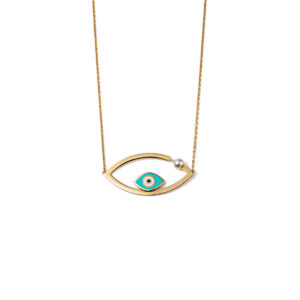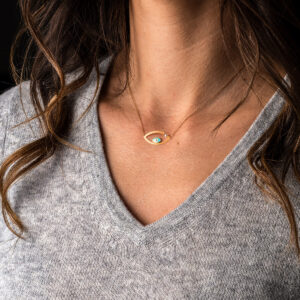En Touto Nika Cross – 18K Solid Gold with Turquoise Enamel
1.386,00€A unique golden cross with turquoise enamel.At the center of the cross there is the inscription “En Touto Nika”, which is literally meaning “in this, conquer”.
Α double headed eagle symbol decorates every edge of the cross.
Handmade with great attention to detail. Inspired by Byzantine Art.
Made of 18k gold. As in all handmade items there may be small differences in weight and dimensions and this is what makes them unique and precious.
18k Gold Blue Ancient Greek Floral Pendant
1.197,00€Ancient Greek Round Pendant with floral motif (four rosette motifs). The pendant is decorated with blue & red enamel and granules of precious metal. The back side of the pendant has no decoration.
Design inspired by the incredible beauty of historical tradition.
Made in 18k yellow gold
Also available with turquoise enamel
Handmade item.
The chain shown is our 14K Gold Rope Chain (not included).
This technique is called Granulation. Granulation (from Latin: granum = “grain”) is a jewellery technique whereby a surface of a jewel is covered with small spheres or granules of precious metal. The technique is thought to have its origins in Mesopotamia about 5,000 years ago.
The rosette (rose) is a timeless jewel, symbol and amulet. The origin of the term is the Greek word for rose – rodon (ρόδον). Its use began in the Mycenaean era and continues as far as the 2nd millennia BC. The Mycenaean Rosette is a motif that was widespread throughout Mesopotamia, Egypt, Greece and other ancient civilizations. It is inspired by a Mycenaean rosette bead, found at Mycenae, dated to 1400-1300 B.C. The rosette was used extensively in ancient Greek Mycenaean jewels, in architecture, pottery and in sculptures from 1500 BC. Mycenaean rosettes usually had 6 or 8 or 12 leaves, and sixteen leaves during the Macedonian Dynasty. Such details as the rodax shape and the number of leaves tend to vary with the era or beliefs. The rosettes were used to decorate the cloths, belts and wreaths of the Kings. The number of leaves had a symbolic character each time. The four elements of nature (wind, earth, fire, water), the seven wonders of the ancient world or the twelve gods of ancient Greeks and the world domination and radiance of the Kings of Macedonia. They were signs of beauty, purity, eugenics, worship and power. Rosette or Rodax was probably the most popular and favorite decorative element in Mycenaean era, classical antiquity and Byzantine times.
18k Gold Ancient Greek Round Floral Rosette Pendant
1.197,00€Ancient Greek Round Pendant with floral motif (four rosette motifs). The pendant is decorated with turquoise & red enamel and granules of precious metal. The back side of the pendant has no decoration.
Design inspired by the incredible beauty of historical tradition.
Made in 18k yellow gold
Also available with blue enamel
Handmade item.
The chain shown is our 14K Gold Rope Chain (not included).
This technique is called Granulation. Granulation (from Latin: granum = “grain”) is a jewellery technique whereby a surface of a jewel is covered with small spheres or granules of precious metal. The technique is thought to have its origins in Mesopotamia about 5,000 years ago.
The rosette (rose) is a timeless jewel, symbol and amulet. The origin of the term is the Greek word for rose – rodon (ρόδον). Its use began in the Mycenaean era and continues as far as the 2nd millennia BC. The Mycenaean Rosette is a motif that was widespread throughout Mesopotamia, Egypt, Greece and other ancient civilizations. It is inspired by a Mycenaean rosette bead, found at Mycenae, dated to 1400-1300 B.C. The rosette was used extensively in ancient Greek Mycenaean jewels, in architecture, pottery and in sculptures from 1500 BC. Mycenaean rosettes usually had 6 or 8 or 12 leaves, and sixteen leaves during the Macedonian Dynasty. Such details as the rodax shape and the number of leaves tend to vary with the era or beliefs. The rosettes were used to decorate the cloths, belts and wreaths of the Kings. The number of leaves had a symbolic character each time. The four elements of nature (wind, earth, fire, water), the seven wonders of the ancient world or the twelve gods of ancient Greeks and the world domination and radiance of the Kings of Macedonia. They were signs of beauty, purity, eugenics, worship and power. Rosette or Rodax was probably the most popular and favorite decorative element in Mycenaean era, classical antiquity and Byzantine times.
18K Gold Turquoise Enamel Earrings
968,00€Byzantine Earrings embellished with turquoise and red enamel and granules of precious metal.
Handmade with great attention to detail. Inspired by Byzantine art.
Made in 18k gold
Granulation (from Latin: granum = “grain”) is a jewellery technique whereby a surface of a jewel is covered with small spheres or granules of precious metal. The technique is thought to have its origins in Mesopotamia about 5,000 years ago.
Minoan Malia Bees Dangle Earrings – 18K Solid Yellow Gold and enamel
945,00€Dangle earrings inspired by the ancient Minoan Greek Malia bees pendant.
Made of 18K Gold.
Handmade item.
The Minoan Bees Pendant, one of the most famous Minoan artworks, was discovered in the Old Palace cemetery at Chrysolakkos, outside the palace of Malia, the third largest and most significant known Minoan palace after Knossos and Phaistos. Chryssolakkos means the “Pit of gold” because of the many precious objects that were found there. The famous pendant dates back to the Bronze Age, (1800 BC) and it’s a stunning, very detailed representation of two bees or wasps storing away a drop of honey in their honeycomb. This pendant is one of the most famous exhibits in the wonderfully Heraklion archeological museum.
As in all handmade items, there may be small differences in weight and dimensions and this is what makes them unique and precious.
Meander Egg Pendant – 14k Gold and Red Enamel
765,00€The pendant is embellished with a Meander design.
Used as a charm or as a pendant.
Pick up a beautiful gift inspired by the majestic art of Fabergé!
Made in 14k yellow gold and red enamel.
The chain shown is our Cable Chain in 14K Gold (not included).
Meander or Meandros design is a decorative border constructed from a continuous line, shaped into a repeated motif. Such a design is also called the Greek fret or Greek key design, although these are modern designations. On the one hand, the name “meander” recalls the twisting and turning path of the Meander River in Asia Minor, and on the other hand, as Karl Kerenyi pointed out, “the meander is the figure of a labyrinth in linear form” the meaning is that there is no beginning and no end in some cases so it becomes the symbol of long life and eternity.
Fabergé egg is a jeweled egg created by the House of Fabergé, in St. Petersburg, Imperial Russia. Virtually all were manufactured under the supervision of Peter Carl Fabergé between 1885 and 1917,[citation needed] the most famous being the 50 “Imperial” eggs, 43 of which survive, made for the Russian Tsars Alexander III and Nicholas II as Easter gifts for their wives and mothers. The first Fabergé egg was crafted for Tsar Alexander III, who had decided to give his wife, Empress Maria Feodorovna, an Easter egg in 1885. Peter Carl Fabergé was a Russian jeweler best known for the famous Fabergé eggs made in the style of genuine Easter eggs, using precious metals and gemstones. He’s the founder of the famous jewelry legacy House of Fabergé.
As in all handmade items, there may be small differences in weight and dimensions, making them unique and precious.
Meander Egg Pendant – 14k Gold and Blue Enamel
730,00€The pendant is embellished with Meander design.
Used as a charm or as a pendant.
Pick up a beautiful gift inspired by the majestic art of Fabergé!
Made in 14k yellow gold and blue enamel
Fabergé egg is a jeweled egg created by the House of Fabergé, in St. Petersburg, Imperial Russia. Virtually all were manufactured under the supervision of Peter Carl Fabergé between 1885 and 1917,[citation needed] the most famous being the 50 “Imperial” eggs, 43 of which survive, made for the Russian Tsars Alexander III and Nicholas II as Easter gifts for their wives and mothers. The first Fabergé egg was crafted for Tsar Alexander III, who had decided to give his wife, the Empress Maria Feodorovna, an Easter egg in 1885. Peter Carl Fabergé was a Russian jeweller best known for the famous Fabergé eggs made in the style of genuine Easter eggs, using precious metals and gemstones. He’s the founder of the famous jewelry legacy House of Fabergé.
Meander or Meandros design, one of the most historic symbols of the Greek World, also called Greek Key and symbolizes long life and eternity.
As in all handmade items there may be small differences in weight and dimensions and this is what makes them unique and precious.
14k Yellow Gold Greek Bouzouki Charm with Turquoise Enamel
730,00€Greek Bouzouki Charm with turquoise enamel decorated with rosette motifs.
Made in 14k yellow gold.
Used as a charm or as a pendant.
Handmade in Greece.
Design inspired by the Greek tradition.
Explore Heritage Collection
History
The Greek bouzouki is a plucked musical instrument of the lute family, called the thabouras or tambouras family. The tambouras existed in ancient Greece as the pandura, and can be found in various sizes and shapes. The bouzouki and the baglamas are the direct descendants. The bouzouki arrived in Greece following the 1919–1922 war in Asia Minor and the subsequent population exchange between Greece and Turkey. The early bouzoukia mostly had three courses. At the end of the 1950s, four-course (tetrachordo) bouzoukia started to gain popularity. The four-course bouzouki was made popular by Manolis Chiotis. Manolis Chiotis was a Greek rebetiko and laiko composer, singer, and bouzouki player. He is considered one of the greatest bouzouki soloists of all time.
Constantinato Rectangle Pendant with Turquoise – Gold 14K
680,00€A handmade gold Constantinato pendant that depicts a cross on the one side and Saints Constantine and Helena on the other side.
A unique pendant that you can offer to your special ones as a protection gift or buy it for yourself.
Made of 14k gold.
Handmade in Greece
Constantinato Pendant with Enamel and Turquoise – 14K Gold
622,00€A handmade gold Constantinato pendant that depicts a cross on the one side and Saints Constantine and Helena on the other side.
A unique pendant that you can offer to your special ones as a protection gift or buy it for yourself.
Made of 14k gold.
Handmade in Greece
Constantinato Pendant with Enamel – 14K Gold
622,00€A handmade gold Constantinato pendant that depicts a cross on the one side and Saints Constantine and Helena on the other side.
A unique pendant that you can offer to your special ones as a protection gift or buy it for yourself.
Made of 14k gold.
Handmade in Greece
Eye Circle Necklace – 14K Gold
510,00€Made of 14K yellow gold
Handmade in Greece
The symbol and superstition of the evil eye is one of the strongest symbolic images in the world. The earliest known evidence for belief in the evil eye goes back to ancient Greece and Rome. It is supposed to wear off evil to anyone who wears it.
18K Gold and Green Enamel Rosette Stud Earrings
462,00€Byzantine Earrings which have the shape of the flower rosette.
Handmade with great attention to detail. Inspired by Byzantine art.
Made in 18k gold and green enamel
Rosette flower
The rosette (rose) is a timeless jewel, symbol and amulet. The origin of the term is the Greek word for rose – rodon (ρόδον). Its use began in the Mycenaean era and continues as far as the 2nd millennia BC. The Mycenaean Rosette is a motif that was widespread throughout Mesopotamia, Egypt, Greece and other ancient civilizations. It is inspired by a Mycenaean rosette bead, found at Mycenae, dated to 1400-1300 B.C. The rosette was used extensively in ancient Greek Mycenaean jewels, in architecture, pottery and in sculptures from 1500 BC. Mycenaean rosettes usually had 6 or 8 or 12 leaves, and sixteen leaves during the Macedonian Dynasty. Such details as the rodax shape and the number of leaves tend to vary with the era or beliefs. The rosettes were used to decorate the cloths, belts and wreaths of the Kings. The number of leaves had a symbolic character each time. The four elements of nature (wind, earth, fire, water), the seven wonders of the ancient world or the twelve gods of ancient Greeks and the world domination and radiance of the Kings of Macedonia. They were signs of beauty, purity, eugenics, worship and power. Rosette or Rodax was probably the most popular and favorite decorative element in Mycenaean era, classical antiquity and Byzantine times.
18K Gold Byzantine Rosette Stud Earrings
462,00€Byzantine Earrings which have the shape of the flower rosette.
Handmade with great attention to detail. Inspired by Byzantine art.
Made in 18k gold and turquoise enamel
Rosette flower
The rosette (rose) is a timeless jewel, symbol and amulet. The origin of the term is the Greek word for rose – rodon (ρόδον). Its use began in the Mycenaean era and continues as far as the 2nd millennia BC. The Mycenaean Rosette is a motif that was widespread throughout Mesopotamia, Egypt, Greece and other ancient civilizations. It is inspired by a Mycenaean rosette bead, found at Mycenae, dated to 1400-1300 B.C. The rosette was used extensively in ancient Greek Mycenaean jewels, in architecture, pottery and in sculptures from 1500 BC. Mycenaean rosettes usually had 6 or 8 or 12 leaves, and sixteen leaves during the Macedonian Dynasty. Such details as the rodax shape and the number of leaves tend to vary with the era or beliefs. The rosettes were used to decorate the cloths, belts and wreaths of the Kings. The number of leaves had a symbolic character each time. The four elements of nature (wind, earth, fire, water), the seven wonders of the ancient world or the twelve gods of ancient Greeks and the world domination and radiance of the Kings of Macedonia. They were signs of beauty, purity, eugenics, worship and power. Rosette or Rodax was probably the most popular and favorite decorative element in the Mycenaean era, classical antiquity and Byzantine times.
18k Solid Gold Round Pendant with Blue and Red enamel
462,00€Ancient Greek Round Pendant with blue and red enamel and granules of precious metal. The back side of the pendant has no decoration.
Design inspired by the incredible beauty of historical tradition.
Made in 18k yellow gold.
The chain shown is our 14K Gold Chain in Length 40cm (not included).
Also available with turquoise enamel
Handmade item.
This technique is called Granulation. Granulation (from Latin: granum = “grain”) is a jewellery technique whereby a surface of a jewel is covered with small spheres or granules of precious metal. The technique is thought to have its origins in Mesopotamia about 5,000 years ago. As in all handmade items, there may be small differences in weight and dimensions and this is what makes them unique and precious.
18k Yellow Gold Minoan Bee Pendant
330,00€This pendant is made in 18k yellow gold with turquoise/ blue enamel inspired by the Minoan Bee Pendant. The Malia honeybee pendant was discovered at Chryssolakkos, of the Minoan Palace of Malia on the island of Crete, and is thought to date to c.1800 BC. The named Chryssolakkos that means the “pit of gold” because of the precious objects that the farmers used to find there. The Minoan Palace is situated 3 km east of Malia town and is the third most significant known Minoan Palace after Knossos and Phaistos.
This pendant is in the shape of two bees, or wasps, storing away a drop of honey in a comb and is one of the most famous exhibits in the Herakleion Museum.
Handmade item.
The chain shown in the third picture is our 14k Gold Twisted Chain (not included).
Evil Eyes Necklace – 14K Yellow Gold with Turquoise Enamel
320,00€Made of 14K yellow gold and enamel
Evil Eye
The symbol and superstition of the evil eye is one of the strongest symbolic images in the world. The earliest known evidence for belief in the evil eye goes back to ancient Greece and Rome. It is supposed to wear off evil to anyone who wears it and various cultures believe in that, however in Greece it’s blue because at that time blue eyes were not so common and were thought to give the evil eye, so the blue is like a mirror to them.
Star Eyes Bracelet – 14k Gold
298,00€Made of 14K yellow gold
Handmade in Greece
The symbol and superstition of the evil eye is one of the strongest symbolic images in the world. The earliest known evidence for belief in the evil eye goes back to ancient Greece and Rome. It is supposed to wear off evil to anyone who wears it.
Turquoise Evil Eyes Necklace- 14K Gold
270,00€Made of 14K gold.
Handmade in Greece.
Explore Mati Collection
Evil Eye
The symbol and superstition of the evil eye is one of the strongest symbolic images in the world. The earliest known evidence for belief in the evil eye goes back to ancient Greece and Rome. It is supposed to wear off evil to anyone who wears it and various cultures believe in that, however in Greece it’s blue because at that time blue eyes were not so common and were thought to give the evil eye, so the blue is like a mirror to them.
White Evil Eyes Necklace- 14K Gold
270,00€Made of 14K gold.
Handmade in Greece.
Explore Mati Collection
Evil Eye
The symbol and superstition of the evil eye is one of the strongest symbolic images in the world. The earliest known evidence for belief in the evil eye goes back to ancient Greece and Rome. It is supposed to wear off evil to anyone who wears it and various cultures believe in that, however in Greece it’s blue because at that time blue eyes were not so common and were thought to give the evil eye, so the blue is like a mirror to them.
Blue Evil Eyes Necklace- 14K Gold
260,00€Made of 14K gold.
Handmade in Greece.
Explore Mati Collection
Evil Eye
The symbol and superstition of the evil eye is one of the strongest symbolic images in the world. The earliest known evidence for belief in the evil eye goes back to ancient Greece and Rome. It is supposed to wear off evil to anyone who wears it and various cultures believe in that, however in Greece it’s blue because at that time blue eyes were not so common and were thought to give the evil eye, so the blue is like a mirror to them.
Evil Eyes Chain Bracelet – 14K Gold and Turquoise White Enamel
260,00€Bracelet representing the evil eye symbol.
Made of 14K gold.
The symbol and superstition of the evil eye is one of the strongest symbolic images in the world. The earliest known evidence for belief in the evil eye goes back to ancient Greece and Rome. t is suppose to wear off evil to anyone who wears it and various cultures believe in that, however in Greece its blue because at that time blue eyes were not so common and were thought to give the evil eye ,so the blue is like a mirror to them.
Evil Eye Chain Bracelet with Cross – 14K Yellow Gold and White Enamel
252,00€Bracelet representing the evil eye symbol.
Made of 14K gold.
The symbol and superstition of the evil eye is one of the strongest symbolic images in the world. The earliest known evidence for belief in the evil eye goes back to ancient Greece and Rome. t is suppose to wear off evil to anyone who wears it and various cultures believe in that, however in Greece its blue because at that time blue eyes were not so common and were thought to give the evil eye ,so the blue is like a mirror to them.
Star Eye Necklace with Enamel – 14k Gold
250,00€Made of 14K yellow gold
Handmade in Greece
The symbol and superstition of the evil eye is one of the strongest symbolic images in the world. The earliest known evidence for belief in the evil eye goes back to ancient Greece and Rome. It is supposed to wear off evil to anyone who wears it.
Evil Eyes Chain Bracelet – 14K Yellow Gold and Enamel
232,00€Bracelet representing the evil eye symbol.
Made of 14K gold.
The symbol and superstition of the evil eye is one of the strongest symbolic images in the world. The earliest known evidence for belief in the evil eye goes back to ancient Greece and Rome. t is suppose to wear off evil to anyone who wears it and various cultures believe in that, however in Greece its blue because at that time blue eyes were not so common and were thought to give the evil eye ,so the blue is like a mirror to them.
Tear Drop Eye Necklace with Enamel – 14k Gold
230,00€Made of 14K yellow gold
Handmade in Greece
The symbol and superstition of the evil eye is one of the strongest symbolic images in the world. The earliest known evidence for belief in the evil eye goes back to ancient Greece and Rome. It is supposed to wear off evil to anyone who wears it.
Blue White Eye Necklace – 14K Gold
230,00€Made of 14K gold.
Handmade in Greece.
Explore Mati Collection
Evil Eye
The symbol and superstition of the evil eye is one of the strongest symbolic images in the world. The earliest known evidence for belief in the evil eye goes back to ancient Greece and Rome. It is supposed to wear off evil to anyone who wears it and various cultures believe in that, however in Greece it’s blue because at that time blue eyes were not so common and were thought to give the evil eye, so the blue is like a mirror to them.
Evil Eyes Chain Bracelet – 14K Yellow Gold and Turquoise Enamel
220,00€Bracelet representing the evil eye symbol.
Made of 14K gold.
The symbol and superstition of the evil eye is one of the strongest symbolic images in the world. The earliest known evidence for belief in the evil eye goes back to ancient Greece and Rome. t is suppose to wear off evil to anyone who wears it and various cultures believe in that, however in Greece its blue because at that time blue eyes were not so common and were thought to give the evil eye ,so the blue is like a mirror to them.
Eye Chain Bracelet – 14K Yellow Gold with Enamel
216,00€Bracelet representing the evil eye symbol.
Made of 14K gold.
The symbol and superstition of the evil eye is one of the strongest symbolic images in the world. The earliest known evidence for belief in the evil eye goes back to ancient Greece and Rome. t is suppose to wear off evil to anyone who wears it and various cultures believe in that, however in Greece its blue because at that time blue eyes were not so common and were thought to give the evil eye ,so the blue is like a mirror to them.
Evil Eye Chain Bracelet with Pearls – 14K Yellow Gold and Turquoise Enamel
204,00€Bracelet representing the evil eye symbol.
Made of 14K gold.
The symbol and superstition of the evil eye is one of the strongest symbolic images in the world. The earliest known evidence for belief in the evil eye goes back to ancient Greece and Rome. t is suppose to wear off evil to anyone who wears it and various cultures believe in that, however in Greece its blue because at that time blue eyes were not so common and were thought to give the evil eye ,so the blue is like a mirror to them.
Evil Eye Necklace 14K Yellow Gold with Enamel
204,00€Made of 14K yellow gold and enamel
Evil Eye
The symbol and superstition of the evil eye is one of the strongest symbolic images in the world. The earliest known evidence for belief in the evil eye goes back to ancient Greece and Rome. It is supposed to wear off evil to anyone who wears it and various cultures believe in that, however in Greece it’s blue because at that time blue eyes were not so common and were thought to give the evil eye, so the blue is like a mirror to them.


